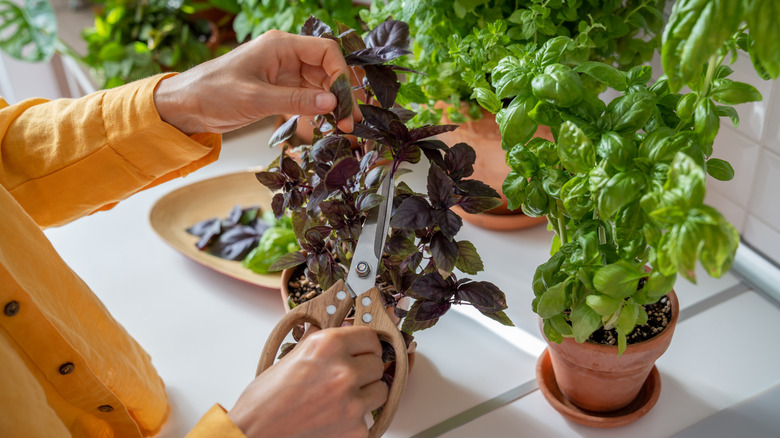What You Need To Do To Keep Your Basil From Turning Bitter
Is there anything more delicious than the aromas and flavors of fresh basil? It boasts notes of mint, licorice, and pepper with an earthy, grassy character. We smell it and immediately picture mouthwatering Italian pastas, Thai curries, or herbaceous, citrusy cocktails and mocktails. But all of that goodness can vanish if you realize your basil is too bitter. Its perfect balance of fresh sweetness, spice, and herby bitterness can tip too far into that latter category, and suddenly that's all you taste, which stands to ruin any dish or drink you want to use it in. The good news is that when you grow your own basil, you have control over this. To avoid bitter basil, simply stay on top of pruning.
Pruning in general is one of the key tips for beginning gardeners — and seasoned ones, too. Like other plants, basil tends to grow better and faster with fuller, more aromatic leaves when it's trimmed. Trimming and pruning dead stems or leaves prohibits any disease that might be in them from spreading to the rest of the plant, and it also allows the remaining leaves to get plenty of the sunlight they need. When basil isn't pruned, its leaves can be affected by disease or lack of sun or air, resulting in a degradation of those sweeter aromas. Plus, where you cut, the plant will grow more stems and leaves to compensate, so you get more healthy basil.
How to prune basil
When basil isn't pruned, it flowers. And that can be pretty, but the plant will no longer taste good — if it starts to bloom, basil will be much more likely to be bitter. When it flowers, basil switches its focus from growing stems and leaves to developing seeds. Pruning prevents this and keeps your basil abundant with lovely leaves. This, however, should be done in the growing season specifically, which runs from later in the spring to about mid-summer. When your basil has reached about six to eight inches in height, that's when you'll prune; this may be every three or four weeks.
Be sure to remove any forming flower buds, but don't remove too many leaves — about half should do the trick without harming the plant. Look for stems that have more than two pairs of leaves growing opposite each other from the same point on the stem, and snip just above the second or third set. Cutting at that place signals to the plant that it's time to grow more leaves. To get the most out of your pruning, use clean shears and don't trim younger basil shorter than about six inches.
Remember that there are all different varieties of basil and ways to use them, so some types might simply lean more bitter. But if basil tastes noticeably bitter in an unbalanced, unpleasant way, your plant needs more attentive pruning. Well-pruned basil is so tasty and sweet, you'll want to candy it.

